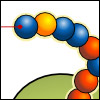Session Overview

|
In this session some variations to the standard mechanisms of DNA replication, transcription and translation are discussed. The minor differences in DNA replication, transcription and translation in eukaryotes, prokaryotes, and viruses are discussed as a way to more fully understand the important processes involved in the copying and expression of genomes. Learning Objectives
|
Session Activities
Lecture Video
Watch the lecture video excerpt
Check Yourself
Question 1
Shown below is the genomic structure of the human β-globin gene. The numbers within the boxes indicate the length (in nucleotides) of each region. The DNA sequences corresponding to the start codon and the stop codon are indicated.
 Which regions are present in the initial transcript?
Which regions are present in the initial transcript?
Both introns and exons are present in the initial transcript.
Question 2
 What is the length (in nucleotides) of the mature, processed β-globin mRNA?
What is the length (in nucleotides) of the mature, processed β-globin mRNA?
Question 3
The following is the sequence of a double stranded DNA molecule: 5’ ATCATGACACTATGCAAGCCGAGAAGCAACAATAGCGAAGCCCATTAA 3’ 3’ TAGTATTGTGATACGTTCGGCTCTTCGTTGTTATCGCTTCGGGTAATT 5’ This DNA can encode…










